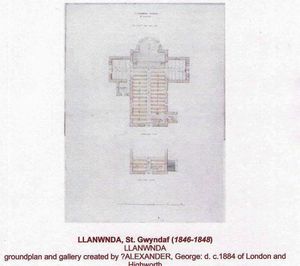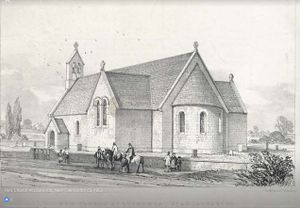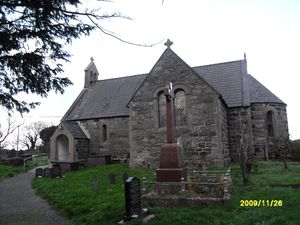Eglwys Sant Gwyndaf, Llanwnda: Gwahaniaeth rhwng fersiynau
Dim crynodeb golygu |
Dim crynodeb golygu |
||
| Llinell 17: | Llinell 17: | ||
Mae disgrifiad manwl ohonnynt i'w weld yn ''"The Royal Commission on Ancient and Historical Monuments in Wales"'' | Mae disgrifiad manwl ohonnynt i'w weld yn ''"The Royal Commission on Ancient and Historical Monuments in Wales"'' | ||
“Fragments of altar tomb to Owen Meredith, 1612; sides against West wall of nave, one end and lower part of top in floor in North transept and nave crossing respectively. The top has a Latin inscription round the edge and shows the lower part of a quartered shield of arms, 3 Owain Gwynedd, 4 Llywarch ap Bran, skull and crossbones below. The end has a shield of arms, quarterly 1 and 4 Llywarch ap Bran, 2 and 3 Owain Gwynedd, impaling 1 semé-de-lis a lion rampant guardant (Holland), 2 Bulkeley, 3 Llywarch ap Bran, 4 a unicorn (probably for Savage). 4 The better preserved side is carved with three deeply-cut, round headed panels, divided by pilasters, with a shallower, rectangular panel at each end. On the left (dexter) panel is a shield of arms, as the impaled coat on the end; the panel left of the centre shows eleven kneeling children; the centre panel carries the inscription; the panel right of centre shows the deceased kneeling at a small desk; and on the right-hand (sinister) panel is a shield of arms, as the impaling coat on the end. The other side has been broken in two pieces placed at the ends of the complete side. Its arrangement was similar save for details: the arms are on the opposite ends: the children’s names, now mostly illegible, are inscribed above their kneeling figures; the centre panel is destroyed; and the figure of the deceased is replaced by that of his wife and four daughters.”<ref>The Royal Commission on Ancient and Historical Monuments in Wales, vol II pp219-220</ref> | “Fragments of altar tomb to Owen Meredith, 1612; sides against West wall of nave, one end and lower part of top in floor in North transept and nave crossing respectively. The top has a Latin inscription round the edge and shows the lower part of a quartered shield of arms, 3 Owain Gwynedd, 4 Llywarch ap Bran, skull and crossbones below. The end has a shield of arms, quarterly 1 and 4 Llywarch ap Bran, 2 and 3 Owain Gwynedd, impaling 1 semé-de-lis a lion rampant guardant (Holland), 2 Bulkeley, 3 Llywarch ap Bran, 4 a unicorn (probably for Savage). 4 The better preserved side is carved with three deeply-cut, round headed panels, divided by pilasters, with a shallower, rectangular panel at each end. On the left (dexter) panel is a shield of arms, as the impaled coat on the end; the panel left of the centre shows eleven kneeling children; the centre panel carries the inscription; the panel right of centre shows the deceased kneeling at a small desk; and on the right-hand (sinister) panel is a shield of arms, as the impaling coat on the end. The other side has been broken in two pieces placed at the ends of the complete side. Its arrangement was similar save for details: the arms are on the opposite ends: the children’s names, now mostly illegible, are inscribed above their kneeling figures; the centre panel is destroyed; and the figure of the deceased is replaced by that of his wife and four daughters.”<ref>The Royal Commission on Ancient and Historical Monuments in Wales, vol II pp219-220</ref> | ||
== | ==Cyfeiriadau== | ||
{{cyfeiriadau}} | |||
Fersiwn yn ôl 11:38, 14 Ebrill 2018



Saif eglwys Gwyndaf Sant yn Esgobaeth Bangor, tua hanner ffordd rhwng Llandudno yn y gogledd Ddwyrain ac Ynys Enlli yn y de orllewin. Dywed traddodiad fod Gwyndaf Hên yn un o feibion Emyr Llydaw. Ebrill 21ain yw ei Wylmabsant. Ail-adeiladwyd yr eglwys yn gyfangwbl yn y flwyddyn 1847. Ar un adeg, safai porth elor yn y fynedfa. Tynnwyd yr oriel yn ystod newidiadau i'r eglwys ym 1964 ac ail-ymroddwyd yr eglwys ar 3 Gorffennaf 1964 gan yr Gwir Barchedig G. O.Williams, Esgob Bangor.
Mae'n adeilad cofrestrig gradd 2* ers 1968.
Y Clychau
Oherwydd cyflwr gwael ffitiadau’r clochdy bu rhaid tynnu’r clychau i lawr yn 2009. Roedd y clychau wedi cael eu canu am 285 mlynedd heb eu cylchdroi, gan achosi i'r un rhan o’r gloch gael ei tharo gan y tafod. Yn ôl cwmni arbennigol, gallai hyn greu hollt yn y gloch ac awgrymwyd y dylid cylchdroi’r ddolen ar ben y clychau er mwyn i’r tafod daro rhan gwahanol o’r gloch cyn eu hailosod yn y clochdy. Yn y cyfamser, maent yn cael eu storio tu mewn i’r eglwys.
Meini Beddrod Owen Mathias
Roedd rhannau nodweddiadol o feini beddrod Owen Meredith wedi eu gosod ar fur orllewinol yr eglwys ers blynyddoedd maith, ac yr oeddynt yn cael eu difetha gan y dwr a dreuddiai trwy’r mur. Er mwyn rhwystro dirywiad pellach, yn 2009 comisiynwyd cwmni arbennigol o Fetws y Coed i’w tynnu i lawr a’u hadfer yn eu gweithdy. Golygai hyn broses araf, ond dychwelwyd y beddrod i’r eglwys yn 2012. Gosodwyd pob darn yn unigol ar blinth ar lawr y groes ogleddol. Mae rhannau eraill o’r feddrod wedi eu mewnosod yn llawr y groes ogleddol ac o flaen grisiau’r allor. Mae disgrifiad manwl ohonnynt i'w weld yn "The Royal Commission on Ancient and Historical Monuments in Wales" “Fragments of altar tomb to Owen Meredith, 1612; sides against West wall of nave, one end and lower part of top in floor in North transept and nave crossing respectively. The top has a Latin inscription round the edge and shows the lower part of a quartered shield of arms, 3 Owain Gwynedd, 4 Llywarch ap Bran, skull and crossbones below. The end has a shield of arms, quarterly 1 and 4 Llywarch ap Bran, 2 and 3 Owain Gwynedd, impaling 1 semé-de-lis a lion rampant guardant (Holland), 2 Bulkeley, 3 Llywarch ap Bran, 4 a unicorn (probably for Savage). 4 The better preserved side is carved with three deeply-cut, round headed panels, divided by pilasters, with a shallower, rectangular panel at each end. On the left (dexter) panel is a shield of arms, as the impaled coat on the end; the panel left of the centre shows eleven kneeling children; the centre panel carries the inscription; the panel right of centre shows the deceased kneeling at a small desk; and on the right-hand (sinister) panel is a shield of arms, as the impaling coat on the end. The other side has been broken in two pieces placed at the ends of the complete side. Its arrangement was similar save for details: the arms are on the opposite ends: the children’s names, now mostly illegible, are inscribed above their kneeling figures; the centre panel is destroyed; and the figure of the deceased is replaced by that of his wife and four daughters.”[1]
Cyfeiriadau
- ↑ The Royal Commission on Ancient and Historical Monuments in Wales, vol II pp219-220